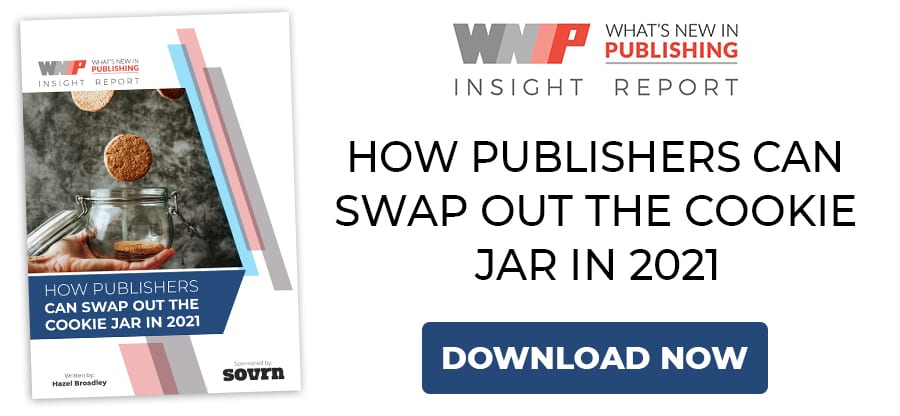|
Getting your Trinity Audio player ready...
|
With Google sunsetting third-party cookies on its Chrome browser next year, we look at what identity solutions are available to publishers and advertisers moving forwards.
We also ask industry leaders their opinion on the steps publishers can take now, as well as which emerging solutions, or combination of solutions, might help publishers pave the way forward in this cookieless future.
This article is an extract from our free to download report, How Publishers Can Swap Out The Cookie Jar.

Act now, hone later
As we bear witness to a number of solutions emerging on the market, it’s important to at least consider – if not act upon – these strategies now. As Cackel suggests, they “have to be initiated now to be fully ready for 2022 when cookies disappear. Some of the required changes, e.g. introducing a login in the user experience of their website, has to be anticipated. Iterations and A/B tests will be required to find the best approach. The future is now.”
White adds: “The faster publishers can build their own first-party data, the better placed they’ll be to thrive into the future. Those who have a direct relationship with their audience will be able to monetize their traffic more easily. For publishers who don’t have the established brands to sustain subscription models, the challenge will be acquiring this data without putting all their content behind logins which will impact the browsing experience.
“Luckily, companies like us are working to roll out products which put consumer privacy first while enabling publishers to build ad-funded business models. And for small and mid-tier publishers, there are free tools available in-market already that allow publishers to collect consent on a more sustainable, cookieless basis, to make sure the open internet can thrive”.
Test and test again
As Hogg reminds us, publishers should “test solutions and strategies while third-party cookies are still around to compare against. Ask for PoCs around Safari and Firefox inventory. The fact that we don’t have cookies in some of the other browsers presents a good opportunity for publishers to test out solutions and tactics today rather than later”.
Erismann adds: “There needs to be a focus on developing and/or fine-tuning strategies for driving authentications. Creating successful authentication strategies means optimizing the various tools publishers and brands have at their disposal, such as subscriptions and newsletters, social logins, premium subscriptions or offerings, content walls, and gated or premium services. These then need to be tested and iterated until they resonate effectively with the target audience”.
Dare to diversify
For Fosci, the key is diversification. “Being small doesn’t mean that you don’t provide value; it just means your audience is smaller. If you’re a niche publisher with a loyal audience, try to create a subscription model or a freemium model. While it may not be viable to hire a full-time data analyst, don’t underestimate the importance of analysis on your bottom line.
Publishers should have more control of their audience data, but they do not need to build their own in-house solutions. History shows that these investments rarely pay off as the technology evolves too fast. Instead, publishers should work with partners that protect and enhance their relationship with their own audiences”.
Remain agile
Munchbach says that “from a short-term perspective, publishers need to embrace agility so they can switch up their strategy as the situation dictates. We saw this with Covid, when publishers removed their paywalls in a matter of hours in an effort to get information out to people. When there’s a huge breaking news event, publishers need to be empowered to make changes in the moment to capitalize on the opportunity”.
The future lies in contextual intelligence, clean rooms and edge computing
While replacement of the cookie with a single universal technology will take time, in the short term we are likely to see a fracturing of ad tech, with several competing replacement technologies appearing before we can determine which will emerge dominant in the marketplace.
As Reischer says, “publishers should have a louder voice in these conversations, especially premium publishers with less dependency on open programmatic demand. At the moment proposals are very much optimized towards advertiser use cases, but we miss the voice of publishers protecting their interests, opportunities and data assets. The death of the cookie is a huge opportunity for publishers to course correct on what has happened, with their data being aggregated at scale, repacked and sold as audiences or models.”
In summary, publishers should avoid a sole reliance on fingerprinting, behavioral targeting, or vertical ad networks. Instead, they should focus on first-party subscriptions and innovations in contextual targeting – think moment targeting – while larger publishers should also consider collaborative clean rooms for accuracy, value and control. Finally, publishers should consider a data-conservative approach to selling remaining inventory via edge computing platforms.
Regardless of which solutions are adopted in the post-cookie era, through collaboration, confidence in their content, and creating a value exchange, publishers large and small can forget about the cookie jar and come out even stronger as we head into 2022.
This article is an extract from our free to download report, How Publishers Can Swap Out The Cookie Jar.

Hazel Broadley,
Author, How Publishers Can Swap Out The Cookie Jar


